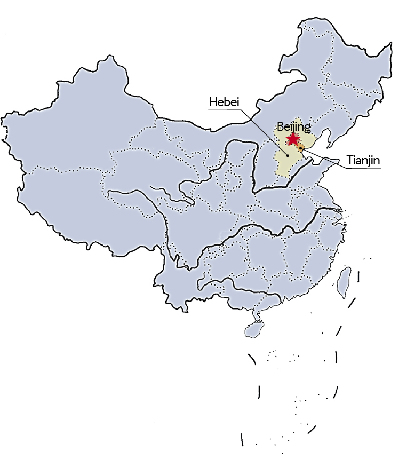|
 |
|
The Xuzhuang section of the Beijing-Tianjin Expressway |
Ren Aifan, a 28-year-old who works in downtown Beijing and dwells in Yanjiao, a town in neighboring Hebei Province, has to spend four hours in commuting every day. "I get on a bus at 6:50 a.m. and take Beijing's Subway Line 1 around 8:00 a.m. When I get off at Chongwenmen Station and arrive in my office, it's usually almost 9:00 a.m.," Ren told Beijing Review, complaining about the crowd in the bus enveloped in the heavy smell of Chinese hamburgers and pancakes.
The formidable, skyrocketing property market has prevented millions of people from purchasing their own homes in Beijing, the national capital already populated by over 20 million people. "The distance I travel every day is not so hard to stomach," said Ren, relating a tale about her friend, who at one time spent 40 minutes queuing up to get on a bus heading for downtown Beijing.
However, there appeared to be hope in sight when Zhang Dawei, Deputy Director of the Comprehensive Planning Department of the Ministry of Transport announced in mid-July that a plan on the synergetic development of transportation integration in the Beijing-Tianjin-Hebei region (Jing-Jin-Ji) has been accomplished and will be unveiled in the near future.
The plan will avail the construction of a Beijing-centered "one-hour rail transportation circle" with a radius of 50-70 km, which is expected to be finished in 2020. Then, roughly 1,000 km of suburban railway will be put in place to connect Beijing, Tianjin and Hebei Province. "The Pinggu Line (in northeast Beijing) will be made an example in the construction of suburban railways. When it goes into operation, millions of people in the Beijing suburbs and parts of Tianjin and Hebei Province will find it much more convenient to go downtown," said Zhou Zhengyu, Director of the Beijing Municipal Commission of Transport.
Rail network
One thing is certain: The current Beijing-centered radial transportation network in the region can no longer fully meet people's travel requirements. In the following years, a multi-center all-encompassing track transportation grid will take shape to interconnect the region.
The track grid is comprised of main line railways, intercity railways, suburban railways and urban railway systems. More specifically, main line railways shuttle between areas over 150 km apart, intercity railways can link major city clusters 70-150 km apart and urban subways primarily fulfill short-distance commuting demands.
Now, what the Jing-Jin-Ji region needs most is a network of suburban railways, which can effectively satisfy the travel demands of those within 30-100 km. "If the plan is put into reality, Beijing will have 1,000 km of subway and 1,000 km of suburban railways," said Zhou. In this way, residents in Beijing's suburban districts, such as Huairou, Pinggu, Miyun and Yanqing, and its neighborhood, such as Heibe's Yanjiao, Langfang and Zhuozhou, will be able to travel to downtown Beijing within one hour.
A total of 27 intercity railways will be constructed to run across the Jing-Jin-Ji region, with total length amounting to 3,796 km. Of them, the construction of the line between Beijing and Tangshan of Hebei and another line between Beijing and Binhai of Tianjin will take place in 2015, and the Langfang-Zhuozhou line and the line connecting the Beijing Capital International Airport with Beijing's new airport will begin construction in 2016.
"The design of a suburban railway network not only calls for support from railway and transport authorities but also needs to be coordinated with city planning. Therefore, its station setting and operating model will not be decided on immediately," said Zhou, who believes suburban railways will significantly enhance traffic convenience in the region.
Moreover, efforts will be made to link dead-end highways with the overall transportation grid and build an integrated system that allows people to use one card to travel by bus or subway in the Jing-Jin-Ji region.

Road bumps
Local governments of the three areas and China Railway Corp. have already set up the Beijing-Tianjin-Hebei Intercity Railway Investment Co. Ltd. to take charge of the planning, financing and investment of intercity railway construction. According to Hao Weiya, the company's president, the four intercity railways slated to begin construction within two years will cost more than 100 billion yuan ($16 billion), and with 10 percent coming from government investment, the remaining 90 percent has to be obtained through multi-channel financing.
"It's a great challenge for a newly established company," said Hao, indicating that the first four railways will adopt a railway-land comprehensive development model. In other words, while the construction of intercity railways can drive the social and economic development of cities and towns along them, earnings yielded from rising land prices would in turn sustain the construction work.
However, since intercity and suburban railways often involve two or three cities, local governments have to reach an explicit agreement before inviting investment. Take Pinggu Line for example. The majority of its construction will be carried out in Beijing, but it's the residents who live in Yanjiao that may benefit most from the program. Given that, local governments should take an initiative to exchange views on deciding investors and ratio of investment and make it clear how to bear the losses incurred by operation.
Aside from that, due to inadequate communication and egoism, there have been several of dead-end highways, which have greatly undermined transportation efficiency in the region. To some extent, the success of the transportation integration plan depends on whether a feasible approach can be found to eliminate conflicts of interest among areas and government departments.
Li Lanbing, an associate professor from the Research Center for China Urban and Regional Economy of Tianjin-based Nankai University, suggested that authorities should invent related mechanisms and systems to help the three areas get rid of self-centered thoughts, so that synergetic development can be fully realized.
Since all three areas will participate in the construction work, the approval process will be complicated and protracted. For instance, at the application and report stage alone, the Beijing-Tangshan railway project has to go through about 30 approval procedures set by related Central Government departments and three local governments.
Beyond that, a unified public transportation card system and a regional clearing and settlement center should be established, because more trans-provincial and trans-city buses and railways will be added to the map as the transportation integration proceeds. Currently, dwellers in Beijing, Tianjin and Hebei enjoy different discounts and preferential policies related to public transportation, which are mainly supported by local fiscal subsidies.
"The transportation integration will help cure the so-called 'urban diseases,' which are incurred by excessive population accumulation in big cities, and make demographic distribution become more rational," said Zhou.
Although there has been no major shareholder in Beijing-Tianjin-Hebei Intercity Railway Investment Co. Ltd., the three areas involved should adhere to the principle of fair cooperation and mutual benefit and balance different interest demands," said Zhou, noting that a negotiation system has been formed to tackle major issues.
Copyedited by Kylee McIntyre
Comments to dengyaqing@bjreview.com | 